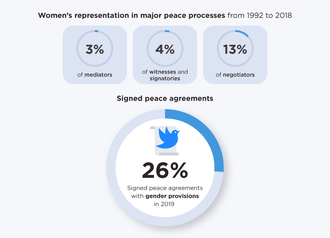Peace process
A peace process is the set of sociopolitical negotiations, agreements and actions that aim to solve a specific armed conflict.[1]
Definitions
Prior to an armed conflict occurring, peace processes can include the prevention of an intra-state or inter-state dispute from escalating into military conflict. The United Nations Department of Peace Operations (UNDPO) terms the prevention of disputes from escalating into armed conflicts as conflict prevention.[2] In 2007, the United Nations Secretary-General's Policy Committee classed both initial prevention of an armed conflict and prevention of the repeat of a solved conflict as peacebuilding.[3]
For peace processes to resolve an armed conflict, Izumi Wakugawa, advisor to the Japan-based International Peace Cooperation Program, suggests a definition of a peace process as "a mixture of politics, diplomacy, changing relationships, negotiation, mediation, and dialogue in both official and unofficial arenas", which he attributes to Harold H. Saunders of the United States Institute of Peace (USIP). Wakugawa categorises these processes into two stages: the ceasing of armed conflict and the processes of sociological reorganisation.[1]
Ceasing of armed conflict
Non-military processes for stopping an armed conflict stage are generally classed as peacemaking. Military methods by globally organised military forces of stopping a local armed conflict are typically classed as peace enforcement.[2]
Reorganisation
The prevention of the repeat of a solved conflict (as well as the preventing of an armed conflict from occurring at all) is usually classed as peacebuilding.[3] UNDPO defines peacebuilding to include "measures [that] address core issues that effect the functioning of society and the State".[2] The use of neutral military forces to sustain ceasefires during this phase, typically by United Nations peacekeeping forces, can be referred to as peacekeeping.[4]
Institutions
The construction of international institutions, especially during the twentieth century, has to a large degree been motivated by the desire to provide a broad global context of peacebuilding. This includes the League of Nations and the United Nations, and regional institutions such as the European Union. Institutions involved in encouraging or overseeing some of the steps in specific peace processes include the United Nations Department of Peace Operations.
Mechanisms
Many specific peace mechanisms can comprise the elements of peace processes. The Peace Accords Matrix of the Kroc Institute for International Peace Studies at the University of Notre Dame, United States, lists some of these as amnesties, ceasefires, arms embargoes, truth and reconciliation commissions and reforms of the constitution, or of military, police, judicial or educational institutions or of the media.[5] Other mechanisms include prisoner exchanges, confidence-building measures, humanitarian corridors, peace treaties and transitional justice.
Women's participation

According to Neville Melvin Gertze of Namibia, speaking at an October 2019 meeting of the United Nations Security Council, peace agreements that are the result of negotiations including women are 35 percent more likely to last at least 15 years than those which are the result of men-only negotiations. At the same meeting, United Nations Secretary-General António Guterres stated that women were excluded from peace processes, attacks against women human rights defenders had increased, and only a "tiny percentage" of funding for peacebuilding was given to women's organisations.[6]
See also
References
- Wakugawa, Izumi (10 August 2012). "Peace Process: The First Step towards Realisation of Peace : @PKO No!w". Cabinet Office (Japan). Archived from the original on 8 November 2019. Retrieved 8 November 2019.
- "Terminology". United Nations peacekeeping. Archived from the original on 8 November 2019. Retrieved 8 November 2019.
- "Peacebuilding & The United Nations". United Nations. 2011. Archived from the original on 27 November 2011. Retrieved 8 November 2019.
- "What peacekeeping does". United Nations. 2019. Archived from the original on 8 November 2019. Retrieved 8 November 2019.
- "PAM collects implementation data on 51 different types of provisions. Click to see accords that contain a particular provision or scroll down for a list of definitions". Peace Accords Matrix. 2019. Archived from the original on 8 November 2019. Retrieved 8 November 2019.
- "Security Council Urges Recommitment to Women, Peace, Security Agenda, Unanimously Adopting Resolution 2492 (2019)". United Nations. 29 October 2019. SC/13998. Archived from the original on 4 November 2019. Retrieved 4 November 2019.